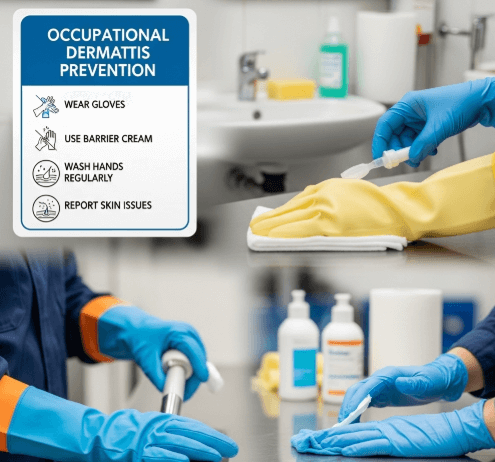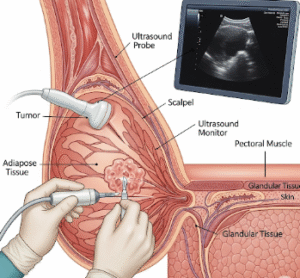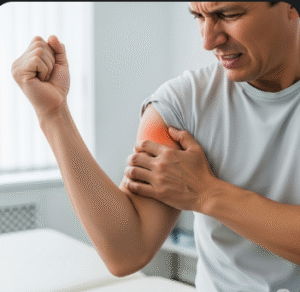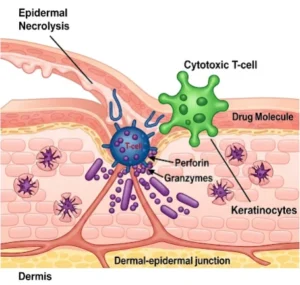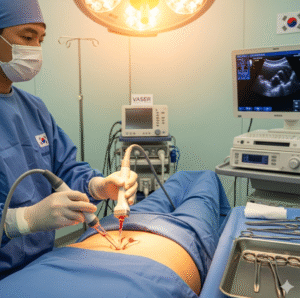What it is
➝ Occupational dermatitis is skin inflammation caused or worsened by workplace exposures such as chemicals, detergents, solvents, metals, rubber, and frequent wet work.
➝ It can be irritant contact dermatitis (ICD) from repeated exposure to harsh substances, or allergic contact dermatitis (ACD) from sensitization to specific allergens.
➝ Commonly affected workers include healthcare professionals, hairdressers, cleaners, food handlers, construction workers, and factory workers.
➝ Prevention strategies are focused on minimizing skin exposure, protecting the skin barrier, and early detection of problems.
➝ In Korea, occupational dermatitis prevention is integrated into industrial health regulations, workplace safety programs, and dermatology-led employee education.
Why it’s done
→ To protect workers from chronic hand eczema, painful fissures, and long-term disability.
→ To reduce workplace absenteeism and compensation claims.
→ To prevent allergic sensitization, which can become permanent once developed.
→ To improve worker comfort, morale, and productivity.
→ In Korea, prevention is a public health priority since occupational dermatitis is one of the most common occupational diseases.
Alternatives / Preventive Strategies
→ Primary prevention (avoid exposure):
- Substitution of hazardous substances with safer alternatives.
- Engineering controls like improved ventilation and automated processes.
→ Secondary prevention (barrier protection):
- Protective gloves (vinyl, nitrile, neoprene depending on allergen/chemical).
- Protective clothing, face shields, or aprons where appropriate.
- Barrier creams and frequent application of emollients.
→ Tertiary prevention (early detection and treatment):
- Skin surveillance programs at workplaces.
- Patch testing for sensitized workers.
- Job modification or reassignment for workers with severe sensitization.
Preparation
→ Risk assessment of workplace exposures, including review of Material Safety Data Sheets (MSDS).
→ Worker training on correct glove use, handwashing routines, and skin moisturization.
→ Baseline skin health checks for high-risk employees.
→ In Korea, companies with hazardous chemical exposure often undergo regular dermatology consultations under occupational health regulations.
How it’s Done
→ Protective equipment:
- Gloves matched to the chemical exposure (nitrile for solvents, vinyl for detergents, cotton liners to reduce sweating).
- Gloves must be changed frequently to avoid occlusion dermatitis.
→ Hand hygiene:
- Use of mild, fragrance-free cleansers instead of harsh soaps.
- Alcohol-based hand rubs (less irritating than soap) in healthcare settings.
- Moisturizer application immediately after washing.
→ Barrier creams and emollients:
- Pre-work barrier creams reduce penetration of irritants.
- Thick emollients used post-shift to restore skin barrier.
→ Education programs:
- Training sessions on early signs of dermatitis.
- Teaching correct glove use, safe handling of irritants, and skincare routines.
→ Medical surveillance:
- Regular skin checks for high-risk employees.
- Referral to dermatology if persistent dermatitis occurs.
Recovery / Outcomes of Prevention
→ Workers using prevention programs experience fewer flare-ups, less itching, and fewer sick days.
→ Early detection prevents progression to chronic eczema or allergic sensitization.
→ Long-term, workplaces see lower healthcare costs and improved productivity.
Complications Without Prevention
→ Chronic hand eczema with painful fissures, bleeding, and infections.
→ Development of allergic contact dermatitis, which may be permanent and require job change.
→ Psychological burden from visible skin disease.
→ Legal and compensation claims for work-related disability.
Treatment and Prevention Options in Korea
→ Korea’s Occupational Safety and Health Act includes skin protection guidelines for at-risk industries.
→ Companies often provide protective gloves, barrier creams, and skin health training to employees.
→ Hospitals and dermatology clinics collaborate with industries to offer patch testing and skin surveillance programs.
→ Educational campaigns emphasize the “three golden rules”:
- Protect (with gloves/barrier creams).
- Cleanse (with mild agents).
- Restore (with emollients after work).
→ Korean dermatologists frequently develop tailored prevention plans for specific industries such as electronics, cosmetics manufacturing, and food handling.
→ With Korea’s structured occupational health system, prevention focuses not just on avoiding disease but also on maintaining long-term skin resilience in the workforce.

